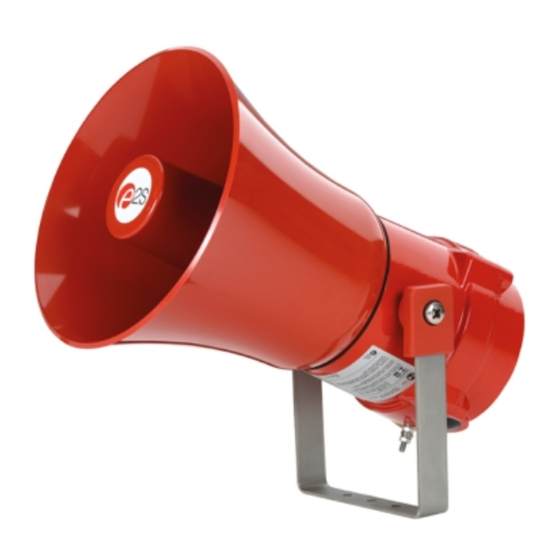
Table of Contents
Advertisement
Quick Links
INSTRUCTION MANUAL
BExL15D & BExL25D
Loudspeakers
ATEx/IECEx & UKEx Gas & Dust
1. Product Table
Unit Type Code
BExL15DFV070
BExL15DFV100
BExL15DFR008
BExL15DFR016
BExL25DFV070
BExL25DFV100
BExL25DFR008
BExL25DFR016
The table shows the input current taken by the various loudspeakers.
Nominal current at nominal voltage.
Table 1: Electrical Ratings.
It is important that the loudspeakers are connected to power amplifiers that have outputs that are compatible to the type of loudspeaker
being used. Loudspeakers with a 70V or 100V line matching transformer fitted must be connected to a power amplifier with a 70V or
100V line output. Low impedance 8 ohm or 16 ohm loudspeakers must be connected to amplifiers with a suitable low impedance
output.
The above table shows the maximum AC signal voltages at which the loudspeakers can be operated
The input current will vary according to the voltage input level and the frequency of the tone selected.
The current levels taken by the each loudspeaker will depend on which output tapping has been selected (see section 12 & 13 of this
instruction manual). BExL25D 70V and 100V Line units have output levels of 25W, 12.5W, 6W and 2W; BExL15D 70V and 100V Line
units have output levels of 15W, 7.5W, 3W and 1W.
2. Warnings
DO NOT OPEN WHEN AN EXPLOSIVE ATMOSPHERE IS PRESENT
DO NOT OPEN WHEN ENERGIZED
POTENTIAL ELECTROSTATIC CHARGING HAZARD – CLEAN ONLY WITH A DAMP CLOTH
COVER BOLTS CLASS A4-80
USE HEAT RESISTING CABLES AND CABLE GLANDS (RATED 110°C) AT AMB. TEMPERATURES OVER
40°C
European Safety Systems Ltd. Impress House, Mansell Road, Acton, London W3 7QH
Document No. D210-00-101-IS
BExL15D
Input
Power
70V Line
15W
100V Lie
15W
8Ω
15W
16Ω
15W
70V Line
25W
100V Lie
25W
8Ω
25W
16Ω
25W
Issue 6
12-09-2022
BExL25D
Max I/P Voltage
70V
100V
10.95
15.49V
70V
100V
14.14
20V
www.e2s.com
Sound
Pressure Level
dB(A)
Max*
Nom
.†
102dB(A) 113dB(A)
105dB(A) 119dB(A)
Tel: +44 (0)208 743 8880
Sheet 1 of 5
Advertisement
Table of Contents

Subscribe to Our Youtube Channel
Summary of Contents for E2S BExL15D
- Page 1 The current levels taken by the each loudspeaker will depend on which output tapping has been selected (see section 12 & 13 of this instruction manual). BExL25D 70V and 100V Line units have output levels of 25W, 12.5W, 6W and 2W; BExL15D 70V and 100V Line units have output levels of 15W, 7.5W, 3W and 1W.
- Page 2 European Safety Systems Ltd. Impress House, Mansell Road, Acton, London W3 7QH www.e2s.com Tel: +44 (0)208 743 8880 Document No. D210-00-101-IS...
-
Page 3: Special Conditions For Safe Use
161.6 the cover in place allowing time for the air to be expelled. Only Fig. 1a Fixing Location for BExL15D Sounder after the cover is fully in place should the four M6 Stainless Steel A4-80 cover bolts and their spring washer be inserted and tightened down. - Page 4 Terminals BExL25D (25W) BExL15D (15W) A – B For use in explosive dust atmospheres, a minimum ingress protection rating of IP6X must be maintained. A – C 12.5W...
-
Page 5: Low Impedance Wiring
(see figure 5 and section 14 of this manual). 12.2 Line Monitoring On BExL15D and BExL25D loudspeakers, dc line monitoring can be used if required. Both the 70V and 100V Line units and the Low Impedance units have blocking capacitors fitted. It... -
Page 8: Eu Declaration Of Conformity
EU Certificate of Conformity for the Quality Assurance System (Module MEDD00000GV Standards applied: EN 54-3:2014 incl. A1: 2019 IEC 60092-504: 2016 E2S Telephone: +44 (0)20 8743 8880 Fax: +44 (0)20 8740 4200 Email: sales@e2s.com www.e2s.com DC-001_Issue_O - Page 1 of 2 - QAF_252_Issue_5... - Page 9 This Declaration is issued under the sole responsibility of the manufacturer. Martin Streetz Document No.: DC-001_Issue_O Quality Assurance Manager Date and Place of Issue: London, 20/04/2022 E2S Telephone: +44 (0)20 8743 8880 Fax: +44 (0)20 8740 4200 Email: sales@e2s.com www.e2s.com DC-001_Issue_O - Page 2 of 2 - QAF_252_Issue_5...
- Page 10 EN 60529:1991 / A1:2000 / A2:2013 - Degrees of protection provided by enclosures (IP code) – enclosure rated IP66/67 E2S Telephone: +44 (0)20 8743 8880 Fax: +44 (0)20 8740 4200 Email: sales@e2s.com www.e2s.com DC-104_Issue_A (BExS, BExL)- Page 1 of 2 - QAF_252_Issue_5...
- Page 11 This Declaration is issued under the sole responsibility of the manufacturer. Martin Streetz Document No.: DC-104_Issue_A Quality Assurance Manager Date and Place of Issue: London, 12/09/2022 E2S Telephone: +44 (0)20 8743 8880 Fax: +44 (0)20 8740 4200 Email: sales@e2s.com www.e2s.com DC-104_Issue_A (BExS, BExL) - Page 2 of 2 - QAF_252_Issue_5...
- Page 12 Page left Intentionally blank...













Need help?
Do you have a question about the BExL15D and is the answer not in the manual?
Questions and answers